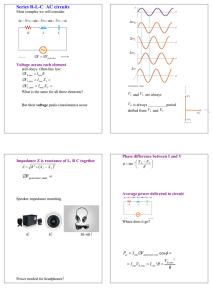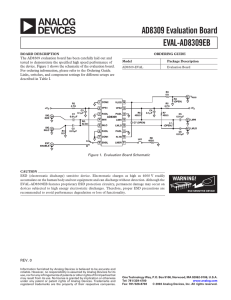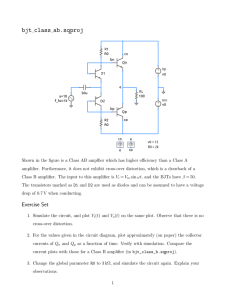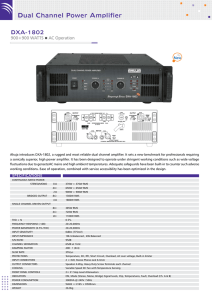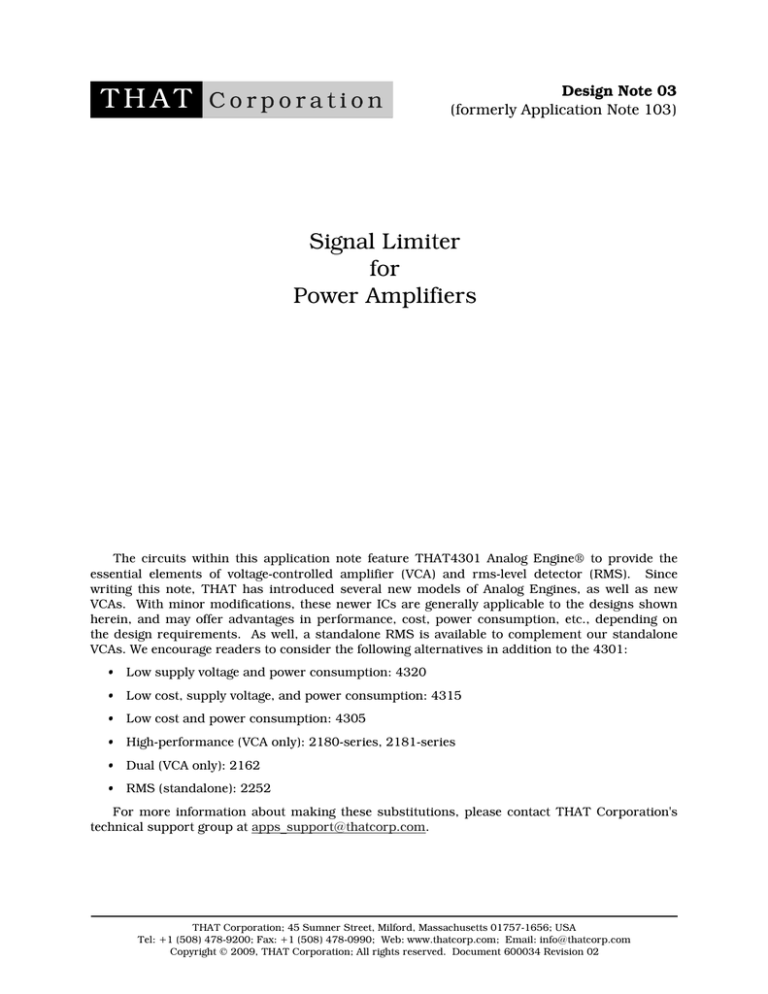
Design Note 03
(formerly Application Note 103)
Signal Limiter
for
Power Amplifiers
The circuits within this application note feature THAT4301 Analog Engine® to provide the
essential elements of voltage-controlled amplifier (VCA) and rms-level detector (RMS). Since
writing this note, THAT has introduced several new models of Analog Engines, as well as new
VCAs. With minor modifications, these newer ICs are generally applicable to the designs shown
herein, and may offer advantages in performance, cost, power consumption, etc., depending on
the design requirements. As well, a standalone RMS is available to complement our standalone
VCAs. We encourage readers to consider the following alternatives in addition to the 4301:
•
Low supply voltage and power consumption: 4320
•
Low cost, supply voltage, and power consumption: 4315
•
Low cost and power consumption: 4305
•
High-performance (VCA only): 2180-series, 2181-series
•
Dual (VCA only): 2162
•
RMS (standalone): 2252
For more information about making these substitutions, please contact THAT Corporation's
technical support group at apps_support@thatcorp.com.
THAT Corporation; 45 Sumner Street, Milford, Massachusetts 01757-1656; USA
Tel: +1 (508) 478-9200; Fax: +1 (508) 478-0990; Web: www.thatcorp.com; Email: info@thatcorp.com
Copyright © 2009, THAT Corporation; All rights reserved. Document 600034 Revision 02
Design Note 03
(Formerly Application Note 103)
Signal Limiter for Power Amplifiers
Abstract
Power amplifiers, when driven out of their
linear range of operation, sound particularly
bad, and can produce damage to themselves or
the transducers to which they are connected.
The design of traditional protection circuits
is complicated by the various performance,
cost, and sonic tradeoffs involved. There is
certainly no one right answer to the limiter
puzzle. The circuits presented here, however,
are designed to maintain a high level of sonic
integrity, while remaining cost-effective.
These circuits combine active limiting with a
diode-based clipper to provide excellent driver
protection while avoiding the sonic degradation
of simpler designs.
An innovative nonlinear
capacitor circuit further improves the sonic
performance of the limiter.
The design is based on the THAT 4301
Analog Engine®, and thus requires only a single
IC, a couple of transistors and diodes, and a
handful of passive components.
Signal Limiter for Power Applications
The simplest circuits used to prevent overload
in power amplifiers usually employ diode clippers.
These have the advantages of being both fast and
inexpensive. They also sound quite unpleasant
when the amplifier is overdriven for more than a
few tens of milliseconds. As a result, users may
avoid fully exploiting the amplifier’s available
headroom because they fear the sonic results of
overload. In the worst case, an amplifier with
otherwise admirable performance may gain a
reputation for poor sound quality.
The significantly improved version shown here
employs two stages of protection — a VCA-based
limiter which quickly and automatically reduces the
input signal level to just below the overload point,
and a conventional diode clipper to handle any
short duration excursions while the limiter stage
reacts.
The circuits shown are built around the THAT
4301 Analog Engine®. The THAT 4301 provides a
single-chip solution for a variety of analog signal
processing applications. It includes a high quality
Blackmer gain-cell VCA, an RMS-level detector, and
three general purpose op amps, two of which are
undedicated. The circuits shown are easily adaptable for use with separate THAT Corporation VCAs
and RMS-level detectors where even higher
performance is required.
Assumptions
We will approach the design of the circuit using
an approximately real-world example with the
following assumptions:
1. The power amplifier’s decibel voltage gain is
32 dB, a common value;
2. The maximum average power that can be dissipated by the 8 Ω load is 600 W;
3. The maximum peak power that can be dissipated by the 8 Ω load is 6 kW.
With these assumptions, we make the following
calculations:
1. The voltage gain of the power amplifier is
32
A V = 10 20 l 40
2. Assuming a sine wave output, the output voltage at
maximum average power dissipation is
Vout max avg P = 600W % 8 = 70V RMS
3. The output at maximum peak power dissipation
is:
Vin max peak P = 6000W % 8 = 220V RMS
Knowing these values, we can calculate the appropriate limiter and clipper output voltages as
Vin max avg P =
70V RMS
40
And Vin max peak P =
= 1.75V RMS
220V RMS
40
= 5.5V RMS
THAT Corporation; 45 Sumner Street; Milford, MA 01757-1656; USA
Tel: +1 508 478 9200; Fax: +1 508 478 0990; Email: info@thatcorp.com; Web: www.thatcorp.com
Copyright © 2009, THAT Corporation; Document 600034 Rev 02
Document 600034 Rev 02
Page 2 of 8
Design Note 03
Signal Limiter for Power Amplifiers
Basic Feedback Limiter with Diode Clipper
The circuit shown in Figure 1 demonstrates the
basic feedback limiter with adjustable clipper. The
input signal is fed to the limiter circuitry at the
node labeled “Input”. The limiter’s output is sent
to the power amplifier from the point labeled “To
Power Amplifier”. In addition, the output from the
power amplifier is fed back to the limiter circuit by
way of the node marked “From Power Amplifier
Output”.
threshold for long, the signal’s rms value will
exceed the limiter’s average power threshold,
causing the limiter to quickly reduce the level of
signal being fed to the amplifier. In this way,
inaudible (but potentially damaging) peaks of short
duration will be clipped, while longer duration
peaks will be handled by the limiter, and little
audible impairment should occur.
The Clipper
Under normal operation, the input signal is
below the limiter’s threshold and so the VCA is at
unity gain, its lowest distortion region.
Figure 2 shows the clipper circuit used in this
design.
A trans-impedance amplifier, OA3,
converts the output current from the VCA to a
voltage which drives the actual clipper circuitry.
When OA3’s output voltage exceeds the threshold
set by VR1, the transistor pair Q1 and Q2 combine
to bypass R2 and clip the output to a fixed level.
For peak output levels of short duration which
exceed the predetermined clip level, the clipper
circuit “hard limits” the output to this level,
performing very much like the (adjustable) diode
clipper that it is. If the output level remains above
+15
R3
10k
Q2
2N3906
D3
1N4148
Symmetry
Adjustment
+15
300k
VR1
20k
+15
R6
VR4
50k
220u
C6
R5
C11
51R
C3
R1 17
Input
20k
22u
14
EC+
SYM
20k
11
13
V+
IN
OUT
GND
EC-
9
OA3
V-
10
-15
R10
Zero dB Reference Level
10k
D1
1N4148
C13
R12
22n
R14
10k
19
OA1 20
U1D
4301P
Clipper Circuit
-15
C7
100n
VCA
18
Q1
2N3904
R4
10k
12
U1A
4301P
16
100k
D4
1N4148
47p
R2
-15
15
To Power Amp Input
D2
1N4148
Make-up Gain Adjustment
+15
+20dB
R8
VR3
50k
1M2
-20dB
-15
Control Port Buffer
7
OA2 6
8
U1C
4301P
RMS
Detector
R13
4
4k99
5
OUT
IN
CT
IT
1
C4
2
U1B
4301P
Threshold
Amplifier
R15
R16
820k
R7
75k
22u
91k
VR2
50k
From Power Amp
Output
R11
10k
R9
2M
-15
Stereo
Connection
C2
220u
Figure 1. Schematic of basic signal limiter
THAT Corporation; 45 Sumner Street; Milford, MA 01757-1656; USA
Tel: +1 508 478 9200; Fax: +1 508 478 0990; Email: info@thatcorp.com; Web: www.thatcorp.com
Copyright © 2009, THAT Corporation
Document 600034 Rev 02
Page 3 of 8
Design Note 03
Signal Limiter for Power Amplifiers
1. Vin dB is the input level in decibels and Vout
the output level in decibels,
is
2. GdB is the VCA gain in decibels, and
+15
R3
10k
dB
3. A is the gain between the detector and the
control port of the VCA.
Q2
2N3906
D3
1N4148
C11
VR1
20k
To Power Amp Input
D4
1N4148
47p
R2
20k
From VCA
OA3
12
R4
10k
U1A
4301P
Q1
2N3904
-15
The minus sign in the side-chain gain equation
comes from the fact that this is a compressor
circuit, and the gain of the VCA moves in the
opposite direction of output signal amplitude.
Combining these equations yields
V out dB = V in dB − A % V out dB
which can be rearranged to form
Figure 2. Detail of clipper circuit
Using our design example, the peak allowable
power is specified as 220 VRMS, and since we are
ultimately clipping the signal to a square wave, this
is equivalent to 220 Vpeak. Given the power amplifier’s gain of 40, the limiter must clip at 5.5 Vpeak.
The two 1N4148 diodes prevent base-emitter
breakdown in Q1 and Q2. The addition of these
diodes means that the clipping voltage will be two
diode drops (approximately 1.2 V) greater than the
voltage at the bases of Q1 and Q2. VR1 adjusts the
voltage at the base of Q1 between 0 and -7.5 V, and
at the base of Q2 between 0 and +7.5 V. Since we
want the limiter to clip at 5.5 V, VR1 should be
adjusted to provide -4.3 V and 4.3 V at the bases of
Q1 and Q2, respectively.
The Limiter
To form the limiter block, the VCA in Figure 1
is configured as a high-compression-ratio feedback
compressor. Under normal operation, the amplifier output is below the compressor’s threshold
voltage, the VCA’s EC- control port is kept at zero
volts, resulting in no compression or limiting
action. Above the threshold level, the threshold
amplifier conducts and closes the feedback loop
from the RMS level-detector to the VCA, resulting in
the desired limiter function.
Figure 3 shows a simplified diagram of a
feedback (FB) compressor. By inspection,
V out dB = V in dB + G dB,
And
V in dB
V out dB
=1+A
This is the compression ratio of the
compressor. To get the compressor to act as a
limiter, we need to set the compression value to a
high value. A suitable and convenient value is 21,
and we can calculate the gain required to achieve
this compression ratio as
A=
V in dB
V out dB
− 1 = 21 − 1 = 20
A side-chain gain of 20 will, therefore, yield a
compression ratio of 21, resulting in the expected
limiter behavior.
The RMS Level-Detector
THAT Corporation’s RMS level-detectors generate an output voltage that is proportional to the
signal power in decibels. A user-programmable
“reference level” determines the signal level for zero
Vin
Vout
Ge
-Ae
Feedback Compressor
G dB = −A % V enc dB, Where
Figure 3. General feedback compressor topology
THAT Corporation; 45 Sumner Street; Milford, MA 01757-1656; USA
Tel: +1 508 478 9200; Fax: +1 508 478 0990; Email: info@thatcorp.com; Web: www.thatcorp.com
Copyright © 2009, THAT Corporation
Document 600034 Rev 02
Page 4 of 8
volts output from the detector. The detector output
will then swing positive (for input signal levels
above the reference level) or negative (for signals
below reference) at a constant 6 mV/dB.
To calculate the true-rms value of an ac input
signal, THAT’s RMS level-detectors first full-wave
rectify, then log the signal. The logged signal is
then doubled, which effectively squares the signal
since the operation is carried out in the log
domain. The subsequent square root operation is
actually performed implicitly at the exponential
input of the VCA.
Design Note 03
Signal Limiter for Power Amplifiers
3rd harmonic distortion in the output of the VCA.
With this in mind, the filter time constants must
balance the need for low distortion with continuous
signals against the need for fast operation in the
presence of transients.
From long experience, a cutoff frequency of
approximately 5 Hz has been found to be an effective compromise. This frequency is well below the
audio band and is sufficient to keep distortion low.
The recommended value for IT (the timing current)
is 7.5 μA, resulting in a timing capacitor of approximately 10 μF.
A better solution to the distortion vs. speed
issue is presented later in this paper as Extra
Credit: The Nonlinear Capacitor.
Zero dB Reference Level
From Power
Amp Output
R16
R15
75k
820k
R11
10k
VR2
50k
R7
91k
C4
22u
R9
2M
RMS
1
4
IN OUT
2
5
CT
IT
U1B
4301P
To Side-chain
-15
Stereo Connection
C2
220u
Figure 4. Detail of RMS detector circuitry
The “mean” operation is carried out by filtering
the rectified and logged signal, and it is this
log-domain filter that sets the time constants
(attack and release times) for the limiter. Referring
to Figure 4, the log-domain filter consists of an
internal diode biased by a fixed DC current (IT),
along with external components R9, which establishes IT, and C2, the timing capacitor itself. The
time constant of the filter is calculated from:
$ = C2 %
VT
IC
and therefore
C2 =
1
2 % % fC %
VT
IC
A compromise is involved in setting the filter
time constants, because the filter also must smooth
the rectified and logged input signal. Without the
smoothing operation, the 2nd harmonic generated
by the rectification process result in high levels of
The above calculations assume a stand-alone
RMS level-detector. When the detector is placed in
a feedback compressor topology, the effective time
constant that results is calculated by taking the
level detector’s stand-alone time constant and
dividing it by the compression ratio. Therefore, if
we plan to operate with a compression ratio of, say,
20:1, we will need to increase the timing capacitor
by a factor of 20. So, for our design the timing
capacitor, C2, becomes 220 μF, the nearest
standard value.
The timing current is set by R9, and is calculated as
RT =
−V SS
IT
=
15V
7.5A
= 2 M
Knowing this, we can calculate the “zero dB reference current” for the RMS level-detector (recall that
this is the input current which result in zero volts
output from the detector. This is also the value that
will produce unity gain through the VCA):
I ref = 1.13 % I T = 8.5 A
As previously stated, this circuit is specifically
designed to limit at 70 VRMS. However, for the sake
of flexibility, we are going to provide a trim to
accommodate a range of 7 - 70 VRMS by adding the
resistive pad composed of R16, R11, and VR2.
This results in an approximately 10:1 divider.
With this pad in place,
reduced to 7 VRMS at the top
Now the input to the RMS
treated as a virtual ground.
a 70 VRMS input is
of the potentiometer.
level-detector can be
Knowing this, along
THAT Corporation; 45 Sumner Street; Milford, MA 01757-1656; USA
Tel: +1 508 478 9200; Fax: +1 508 478 0990; Email: info@thatcorp.com; Web: www.thatcorp.com
Copyright © 2009, THAT Corporation
Document 600034 Rev 02
Page 5 of 8
Design Note 03
Signal Limiter for Power Amplifiers
R10
10k
D1
1N4148
C13
To VCA
Control Port
22n
R14
19
OA1 20
U1D
4301P
R12
10k
7
OA2 6
1N4148
R8
From RMS
Detector
4k99
8
Make-up Gain Adjustment
+15
+20dB
100k
18
R13
D2
U1C
4301P
Threshold
Amplifier
VR3
50k
560k
-20dB
-15
Control Port Buffer
Figure 5. Detail of side-chain circuitry
with the detector’s reference level, we can calculate
the largest value of input resistor required as,
R RMS IN =
7V RMS
8.5A
A buffer =
= 820 k
This is the value that will be seen by the detector when the wiper of VR2 is at the bottom of its
range.
At the other extreme, we desire the limiter to
respond at a power amplifier output of 7 VRMS. At
this level, the 10:1 pad will result in 0.7 VRMS at the
top of VR2. The resistor value required to generate
the detector’s reference level is
R RMS IN =
0.7V RMS
8.5A
The gain of the control port buffer is,
−R14
R12
−100 k
10 k
=
= −10
for a net gain of 20.
To make the circuit more versatile, an optional
“make-up gain” circuit comprised of R8 and VR3
has been added to allow for convenient manual
gain adjustment of the limiter circuit over a range
of ±20 dB. To calculate the sensitivity of the
make-up gain circuit, we first compute the current
sensitivity at the inverting input of OA1,
= 82 k
I
dB
=
6.5 mV
dB
R12
13
mV
A
dB
= 10 k
= 1.3 dB
By choosing a value of 91 kΩ for R7, we get
81 kΩ as the parallel combination of R15 and R7
when VR2 is at the top of its range.
The Side-chain
The circuit in Figure 5 shows an isolated view of
the side-chain of Figure 1. When the signal is
above the limiter threshold voltage, the gain for the
threshold amplifier is,
Since the maximum voltage across R8 is ±15 V,
and we want the resulting current to cause a ±20
dB swing,
R8 =
15V
20 % 1.3
A
dB
= 576 k
560 kΩ is the closest 5% value to the calculated
A threshold =
−R10
R13
=
−10 k
4.99 k
= −2
value.
THAT Corporation; 45 Sumner Street; Milford, MA 01757-1656; USA
Tel: +1 508 478 9200; Fax: +1 508 478 0990; Email: info@thatcorp.com; Web: www.thatcorp.com
Copyright © 2009, THAT Corporation
Document 600034 Rev 02
Page 6 of 8
Design Note 03
Signal Limiter for Power Amplifiers
internal to the IC. During transients, the diode will
conduct only during short periods, and this can
result in high peak currents. In order to prevent
these currents from injecting unwanted signals
elsewhere in the circuit, a charging current path
directly from VCC is usually required.
Other Issues
The VCA in the THAT 4301, like all of the THAT
Corporation’s Blackmer gain-cell VCAs, operates in
Class AB mode. Due to minor differences between
the transistors in the gain cell, there is often a
slight asymmetry between the gain of upper and
lower halves of the output waveforms. The result
of this asymmetry is a potential maximum THD+N
of 0.7% at unity gain.
To accomplish this, C6 should be placed so that
its grounded side is close to the grounded side of
C2, and these two devices should connect to each
other before connecting to system ground.
If this maximum THD+N is acceptable in a
given application, no external distortion trim (R6
and VR4 in Figure 1) is required. This might be
the case, for example, where the limiter is feeding a
subwoofer
amplifier
or
other
low-fidelity
application.
Closing Thoughts
Although speaker protection can be had with
lower-cost amplifier clipping circuits, peaks of long
duration may still result in speaker damage. As
well, the sound of low-cost clippers may keep users
from using the maximum headroom available from
an amplifier.
With the distortion trim, THD+N can be
reduced to maximum 0.007% (unity gain with
0 dBV input at 1 kHz).
The high-fidelity limiter described in this application note keeps an amplifier sounding good even
when its input is overdriven. The result is a
cleaner, more powerful impression, and better
protection for the speaker system.
An
important
application
consideration
concerns the bypassing and layout of the THAT
4301. As was mentioned in the section on the RMS
level-detector, the timing capacitor is part of a log
filter composed of the capacitor and a diode
R15
From Power Amp
820k
4
To Side-Chain
IN
OUT
RMS
5
CT
1
C4
2
R7
100k
22u
IT
U1B
4301P
VR2
50k
R9
2M
-15
R17
D5
2M
D6
MBD101
MBD101
C8
C1
1u
47n
2
1
R18
3
U2A
LF353
200R
C5
10u
Figure 6. RMS detector with nonlinear capacitor circuit
THAT Corporation; 45 Sumner Street; Milford, MA 01757-1656; USA
Tel: +1 508 478 9200; Fax: +1 508 478 0990; Email: info@thatcorp.com; Web: www.thatcorp.com
Copyright © 2009, THAT Corporation
Document 600034 Rev 02
Page 7 of 8
Design Note 03
Signal Limiter for Power Amplifiers
Extra Credit: The Nonlinear Capacitor
We mentioned earlier that RMS level-detectors
exhibit low-frequency 2nd harmonic ripple (the
result of their finite averaging time) which results
in a 3rd harmonic component from the VCA. We
nearly eliminated this component by way of the log
filter capacitor, C2. However, while increasing the
value of this capacitor provides good distortion
performance, it also results in slower response
time than may be desired in some applications.
2. The value of C8 is chosen so that fC resulting
from C8 and R17 is below the audio range,
fC =
1
2 % R17 % C8
= 1.6 Hz
3. It may be shown that, when log-based RMS
level-detectors are connected to exponentiallycontrolled VCAs, the ratio of the ripple-induced 3rd
harmonic to fundamental for a given τ at a given
frequency ω is,
In order to keep distortion low and provide
rapid response to transient signals, a “nonlinear
capacitor” (NLC) circuit can be incorporated in the
design. This circuit effectively changes the timing
capacitor value based on the characteristics of the
incoming signal.
I 3rd
I 1st
=
This may be rearranged to give,
$2 =
In the NLC circuit, the RMS level-detector is
configured as a typical detector, but the timing
capacitor is replaced with C1 (see Figure 6), which is
connected to the virtual ground of op amp U2A. The
gain of this stage is set by the ratio of C1 and C8.
Dynamically, C1 and C5 are in parallel. Under
conditions where the op amp’s output is not limited
by D5 and D6 (”slow mode”), C5 is effectively multiplied by one minus the closed-loop gain of the U2A,
the result of the well-known Miller Effect. When D5
and D6 limit the output of the op amp, C5 (with no
Miller Effect multiplication factor) is simply in
parallel with C1 (”fast mode”).
The simplified transfer functions for this circuit
are:
For Steady-State Inputs: C TIME = C1 + C5 % 1 + C1
C8
For Transient Inputs:
C TIME = C1 + C5
Here are some important design equations and
a few tips on fine-tuning the values in the NLC
circuit:
1. The value of R17, the resistor which provides
a return path for the op amp’s bias current, is
chosen to produce a minimal DC offset as a result
of the bias current. If your diodes are leaky, you
may be able to use a much larger value of R17.
1
4 1 + (2 * ) 2 $ 2
2
I 1st
4 % I 3rd
(4 f
−1
)2
Presumably, one intends to design a low distortion circuit and, therefore, we may assume that,
I 1st
I 3rd
>> 1
Consequently,
$2
l
I 1st
4 % I 3rd
2
(4 f ) 2
We may then state that
$l
I 1st
4 % I 3rd
(4 f )
=
I 1st
16 f % I 3rd
Assume that we are willing to accept 1%
THD+N at 50 Hz. We can then calculate (for slow
mode operation)
$ Slow l
I 1st
16 f % I 3rd
=
1
16 f
%
I 1st
I 3rd
or
$ Slow l
1
16 % 50 Hz
% 100 = 0.04 s
A relatively complex analysis that is beyond the
scope of this paper will show that the average
ripple voltage at a given τ and frequency is,
V R avg =
VT
2 2 %*$
=
VT
4 2 %f$
THAT Corporation; 45 Sumner Street; Milford, MA 01757-1656; USA
Tel: +1 508 478 9200; Fax: +1 508 478 0990; Email: info@thatcorp.com; Web: www.thatcorp.com
Copyright © 2009, THAT Corporation
Document 600034 Rev 02
Page 8 of 8
At room temperature, VT = 26 mV, and from
our design requirement, the frequency of interest is
50 Hz. Therefore,
V R avg =
0.026 V
, or
4 2 % 50 Hz % 0.04
VR avg = 731 V = 1.03 mVpeak
We can convert this to decibels by dividing the
result by the THAT 4301’s control voltage constant
(6.5 mV per dB),
V R avg dB =
1.03 mV
V
0.0065 dB
IT
VT
We choose to allow 3 dB of change at the detector output before the diodes turn on and switch to
fast mode. This provides ample margin above the
0.16 dB calculated in section 3 above, thus preventing 50 Hz sine wave signals from activating fast
mode.
If we use Schottky diodes, and allow for the 3
dB swing before diode turn-on,
AV =
0.4 V
3 dB % 6.5
which sets
capacitors,
= 0.16 dB
4. Let us assume that we want the NLC’s fast
mode to be 20 times faster than the slow mode. We
can use the equation,
C Slow = C.R. % $ Slow
Design Note 03
Signal Limiter for Power Amplifiers
l 220 F
(where C.R. = the compression ratio)
to determine the required effective timing
capacitance in slow mode. The fast mode capacitance would then be,
AV =
mV
dB
l 20.5
the
ratio
of
the
gain-setting
C1
C8
Note that if an even larger band is needed, one
may use the transistor arrangement shown in
Figure 2 in place of diodes in this circuit.
6. Combining some of the equations in 4 and 5
above, we may state that,
C1 + C5 % 21.5 = 220 F
and
C Fast =
C Slow
20
= 11 F
C1 + C5 = 11 F
The slow mode capacitance is calculated as,
C Slow = C1 + C5 1 +
It follows that,
C1
C8
whereas the fast mode capacitance is simply C1
in parallel with C5, or
C Fast = C1 + C5
Since we
capacitance,
already
11 F − C5 + C5 % 21.5 = 220 F
and then
C5 =
know
our
desired
fast
C1 = 11 F − C5
220 F −11 F
20.5
= 10.2 F
We can now determine that
C1 = 11 F − 10.2 F l 1 F
and finally
5. The required gain is determined by calculating how many decibels will correspond to a single
diode drop. Green LEDs have a forward drop of
approximately 2.2 V, while red LEDs have a
forward drop closer to 1.6 V.
Anti-paralleled
silicon diodes have a forward drop of about 0.65 V,
and anti-paralleled Schottky and germanium
diodes have a forward drop of approximately 0.4 V
(all depending, of course, on the current through
the diode).
C8 =
C1
20.5
= 47 nF
This circuit can be used to replace C2 in
Figure 1. By doing so, the basic limiter circuit
becomes much more flexible, eliminating the need
to trade fast attack times for distortion
performance.
THAT Corporation; 45 Sumner Street; Milford, MA 01757-1656; USA
Tel: +1 508 478 9200; Fax: +1 508 478 0990; Email: info@thatcorp.com; Web: www.thatcorp.com
Copyright © 2009, THAT Corporation

